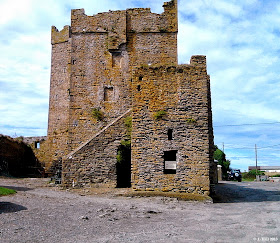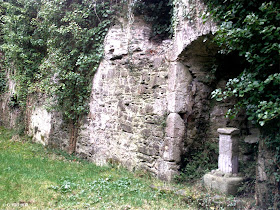Above Image: The central arch
Above Image: Door in the West wall
Above 2 Images: The top of the belfry juts out of
the overgrowth
Constructed in the 15th century on the site of an earlier chapel and affiliated to the Monastery of the Blessed Virgin Mary, this parish Church was dissolved along with the said Monastery in 1539 at the height of the dissolution. The Church was dedicated to St. Cuthbert of Lindisfarne (635AD-687AD) a much loved and revered saint. It is located in St Cuthbert's Park, a green area in Deansrath near Clondalkin.
Arriving at the park you would hardly know the ruins were there if not for the top of the belfry tower jutting up from the clump of trees and brambles that it is secluded in. Some years ago the entire Church was more visible but times have changed and some neglect has resulted in today's situation.
The park is surrounded by a large housing estate so it was easy to park and get access to the green area. Its a short walk over to the clump of trees and a foot worn gap in the brambles and nettles gives access to the ruins.
It's a bit of a shock at first sight.
The trees have encroached on the building and the graffiti artists have had a field day. Not only that but parts of the walls inside have been scorched from camp fires burned recklessly. To compound matters further the ground is littered with squashed beer cans, remnants of the type of unsociable activity that are a scourge to sites like these. A very sad case indeed for the ruin hunter to find.
Somehow even considering the above I still find myself drawn to these ruins. They are an ancient oasis in a sea of suburbia and silence permeates these walls as if the Church were in some rural isolation with the only noise heard being the crackling of brambles underfoot as you traverse the site.
The Church itself is large enough measuring 40ft X 17ft consisting of a nave and chancel. The fine central arch has an extension upwards to accommodate two bells
If cleared and cleaned up this would be a formidable ruin and a focal point in the area. A local heritage group was striving to do this a while back with the local council but so far unfortunately, perhaps because of council cutbacks, nothing has been done. Hopefully some success will come soon so future visitors can enjoy it.
Sadly on our visit which was in evening time we felt it better not to hang around too long with light failing and besides the state of the Church was a bit depressing.
To find the ruins, from the N7 Naas Road take the R113 junction (At Bewley's Hotel) heading northwards (Fonthill Rd) and drive about 1KM until you reach a small roundabout. Go straight through to the next roundabout and turn left onto the R134 New Nangor Road. Continue for approx. 700m until you come to a crossroads. Turn right onto St. Cuthbert's Road and drive until you have gone straight through two small roundabouts. About 150m past the 2nd roundabout turn right onto Deansrath Road. Drive to the end of the road to a T-Junction and turn right. About 50m along this road it bends sharply right. Park just after the bend and you will see the small metal gate to the park behind you at the corner of the bend. follow the footpath towards the clump of trees with the belfry jutting out. You will find a gap in the brambles along the Eastern edge. Wear solid shoes and long sleeves as there are tall nettles in parts.






















































